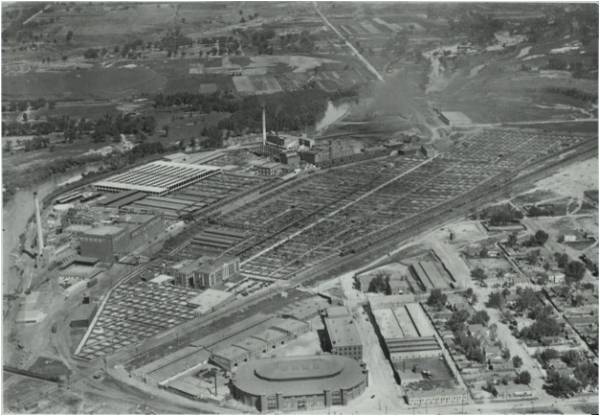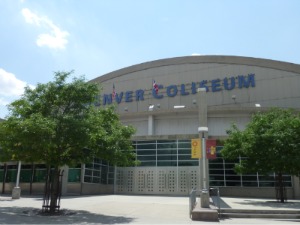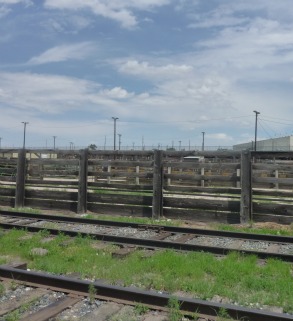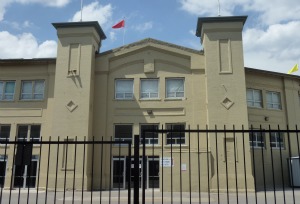Denver’s Meatpacking and Agricultural Legacy
The longtime site of the National Western Stock Show in north Denver is being redeveloped into the new National Western Center. While the project is bringing new and modern buildings to house the Stock Show and other year-round activities, the site features historic buildings and assets dating back as early as 1898 — many of which will be preserved.
Why it Matters
The site’s historic buildings and assets tell its story and the story of Denver’s early and enduring role as a “cow town.”
Historic Denver’s Role
Historic Denver first began advocating for the site’s history and its historic buildings in 2011 as the National Western Stock Show considered its options, including the idea of leaving Denver. Historic Denver developed educational presentations and supported historic resource inventories and evaluations, and over time helped to craft preservation plans as part of the site master plan approved by Denver City Council. Historic Denver served on the National Western Center’s Citizens Advisory Committee, and provides active guidance and advocacy for the site’s historic buildings and cultural heritage. We’ve succeeded in protecting numerous buildings, including two that are now Denver Landmarks.
It’s critical that the project preserve key buildings, reuse other key historic assets such as lumber from the stockyards, and interpret the history of the place and its role in the city’s evolution from agricultural and industrial to the Denver of today.
Background
In late 2020 a new owner purchased the Livestock Exchange Building at the heart of the National Western Campus. The oldest and most striking building on the site, the three-part building was once the bustling heart of the stock yards, with trains passing just beyond the front door and a full bank located inside. The western-most portion of the building is still home to the popular Stock Yard Saloon. The consortium that now owns the building has committed to applying for landmark designation. Learn more via the Colorado Sun.
The Armour Building at 5001 Packing House Road became one of six new Denver landmarks in 2019. The designation was another step in the implementation of the campus master plan. The building was constructed in 1917 for the meatpacking company and today is all that remains of the once bustling business adjacent to the stockyards. While not a part of the designation, the nearby water tower has also been saved and moved so that it can remain an orienting site feature for north Denver.
The building at 4701 Brighton Boulevard was built in 1906 and served as an important hub of activity and culture for the Elyria neighborhood for more than a century. The former grocery was slated for demolition as part of the Brighton Boulevard project, but through our efforts, and with the assistance of History Colorado and the City and County of Denver, we were able to develop and implement a creative solution: carefully documenting the entire structure, dismantling it piece by piece, and storing it nearby so that it can be reconstructed near its original location as the site’s plans unfold. We believe it can become a human-scaled anchor on the eastern side of the campus, and serve as a link to the neighborhoods nearby.
In 2016 the 1909 Stadium Arena became the first National Western building designated a Denver landmark. The building was the first building constructed for the exclusive use of the Stock Show. It’s a rare example of Neoclassical style architecture outside of downtown and its original brick oval-shaped walls are largely intact, allowing them to be readily revealed as proposed by the National Western Center Master Plan. Historic Denver has participated in studies and a feasibility analysis to determine a viable future use — ideally one that also meets community needs.
Get Involved
A Historic Denver membership not only provides financial support so that our staff can work every day on behalf of historic places — it also demonstrates that our community cares. You can take action by becoming a member today.
Updated May 2022
A Brief History of the Site
While it’s difficult to pinpoint the exact beginnings of the National Western legacy, it’s clear its roots lie with the Stock Yards themselves and Denver’s early and enduring role as a “cow town.” This connection is evidenced by the oldest structure on the site, the center section of the Livestock Exchange Building, completed in 1898. Facing the railroad tracks and originally surrounded by cattle pens this building is at the heart of the Stock Show site and two subsequent additions, one in 1916 and one in 1919, make it a striking property.
By 1900 the cattle pens and land around the Livestock Exchange handled 239,000 cattle, 115,700 hogs, 306,109 sheep and 22,700 horses.

Livestock Exchange circa 1900; Source: Denver Public Library
Original 1898 section of the Livestock Exchange Building, surrounded by cattle pens. Photo Credit: Western History Department, Denver Public Library.
The five-story 1916 portion, which is the most recognized and prominent, was constructed by the general contracting firm of Allison Stocker and John H. G. Fraser for one million dollars. The building housed the offices of the Denver Union Stock Show Company, the first force behind the National Western Stock Show. The building also housed the Denver Daily Record-Stockman newspaper, a restaurant, a cigar store, the Stockyards National Bank, the Colorado State Farm Bureau, and the local office of the U.S. Bureau of Agricultural Economics. Today the building is privately owned and remains in good condition, with amazing intact interior details.
As the Livestock Exchange Building evolved so did the Stock Show itself. The first show, known as the Western Livestock Show opened on January 26, 1906 under a circus big top. In 1907 and 1908 the show was held under a “monster” 150 x 175 foot tent. It was not until 1909, after the completion of the National Amphitheater, that the show was held in a proper structure.

Arena circa 1909 Source: Denver Public Library
The National Amphitheater and Livestock Pavilion, today known as the Arena, was built in eight months and completed in time for the show on January 18, 1909. The building was a massive structure for the time, measuring 250 x 350 feet and seating 6,000. The interior columns are steel, as are the long girders spanning the 90 x 250 feet open arena. The walls are made of brick with massive steel pilasters that are four feet thick. This all rests on a huge concrete pad foundation and supports a wooden arched roof. In 1909 green tanbark (shredded bark similar to mulch) covered the floor and the arena, which was lit with large flaming arc lamps and skylights. The original Arena was steam-heated and had stalls for livestock under the seats. The Arena was designed in neoclassical style with pedimented entries framed by twin towers. Flagpoles were built on top of the pilasters to fly the 12 flags of the Rocky Mountain States. The arena cost $200,000 to build in 1908 and was paid for by a consolidation of Swift, Armour, and other packers that operated the Denver stockyards. Over the years additions and alterations have been made to the structure that somewhat obscure its original exterior appearance. The Arena is owned by the Stock Show.

Coliseum & Arena circa 1952, before the installation of 1-70. Courtesy of Thomas J. Noel from his book Riding High: Colorado Ranchers & 100 Years of the National Western Show.
In 1945 the National Western Stock Show began campaigning for a new stadium. They decided to team up with the City of Denver and build a stadium that could be used for large events, such as basketball, ice hockey and track meets, not just the stock show. In 1947 a $1.5 million bond was passed by the city voters to build a “Municipal Coliseum.” The National Western Stock Show, the Denver Union Stock Yard Company, and other livestock interests raised another $750,000 toward the construction project. Fortunately, the land was donated by the Colorado and Southern Railroad. Interestingly, the previous occupant was the Grant Smelter, which was demolished in front of a crowd of 100,000 in the 1950s.
Work began on the Coliseum on September 19, 1949 and it was dedicated on January 10, 1952. The New York and Chicago-based architectural engineering firm of Lorimer and Rose worked on the new stadium with consulting Denver architect Roland L. Linder. Linder worked with Eugene Groves from 1921 to 1929 and then Allied Architects from 1929 to 1931. Linder supervised the completion of the City and County Building in Denver as part of Allied Architects. From 1931 to 1951 Linder had his own architectural firm and designed the Loveland Community Building (1937), the Fort Collins Library (1938), the Denver Museum of Natural History Auditorium (1939), and the wings of the Museum of Natural History (1948). Linder’s clean, smooth lines can be seen in the modern design on the Coliseum.
When the Coliseum was built it was a state of the art building constructed with steel reinforced concrete. Construction of the building used 100,000 sacks of cement, 1,200 tons of reinforced steel and 575,000 feet of lumber. To allow an unobstructed view from the 8,006 permanent seats, the ceiling was built with six huge arches and no pillars for support. This concrete roof weighs more than 5400 tons. In total the building measures 306 feet x 400 feet and has an 87 foot high ceiling. The structure was completed before the construction of 1-70 and was easily connected to the older Stadium Arena. After the highway and viaducts were built in the 1960s this connection became more challenging. Today the Coliseum is still owned by the City of Denver.
Perhaps the most quintessential structures on the Stock Show site are not buildings at all, but the cattle pens, or stockyards, which existed even before the National Western Stock Show. The official stockyards, owned by the Denver Union Stock Yard Company, opened in 1886. These yards were located between the South Platte River and the railroad tracks and Franklin Street, bounded by 46th Avenue on the south and 52nd avenue on the north. By 1905 the stockyards covered 105 acres and handled 239,500 cattle, 115,700 hogs, 306,109 sheep, and 22,700 horses and mules a year.
The stockyards are where most of the buying and selling of livestock has traditionally taken place and so are in many ways the heart of the National Western Stock Show. In fact, the National Western Stock Show is one of the few stock shows that still use its historic wooden pens. The National Western has been restoring the old wooden display pens and the large outlying turnout corrals. Many of the pens retain their antique wrought iron gates and hinges along with original cobblestone or brick footing, with some bricks stamped “1898.”

Stock Show & approximately 105 acres of Denver Union Stock Yards circa 1940. Arena can be seen in the lower center. Photo Credit: Western History Department, Denver Public Library.
1859 Elephant Corral in LoDo used for livestock shows and auctions.
1881 Denver Union Stockyard Company founded.
1886 Stockyards open in current location.
1898 National Stock Growers Association created at first major stock convention, which ended in a near riot because of the free beer provided on the final day.
1898 Oldest section of what is now the Livestock Exchange Building constructed for the Denver Union Stockyard Company.
1900 Stockyards cover over 105 acres
1906 First Stock Show opened under a circus big top and the Western Stock Show Association created.
1907 A “monster” 150 x 175 foot tent was manufactured by a local awning company as the venue for the next two Western Stock Shows.
1909 The newly constructed 6,000 seat National Amphitheater (Arena) opened.
1911 Two and three story barns and a club building constructed.
1916 The elegant east portion of the Livestock Exchange Building opened.
1919 The western section of the Livestock Exchange Building opened.
1942 The WPA constructed a huge concrete barn on the facility and a Quonset hut was installed next to the barn.
1952 The Denver Coliseum was dedicated on January 10 for the 46th National Western.
1962 The Denver Union Stock Yard Company built an auction arena in the yards.
1973 The two-level 300 x 390 foot Hall of Education was opened to the public. The Beef Palace, Horse Center, and National Western Club also opened.
1987 The International Center opened.
1991 The Expo Hall and Stadium Hall opened.
1995 The National Western Events Center, a state-of-the-art equestrian arena with a 150 x 300 foot floor opened, and the Paddock and Horse Barn completed.
In 2007 the Colorado Department of Transportation began a study of all the potential historic resources in the area impacted by plans for the expansion of 1-70. This study of course included the National Western Stock Show site. The study was required because the National Historic Preservation Act of 1966 requires historical analysis and public processes anytime a federal action, including a federally funded action, impacts historic places. Additionally, historical analysis of this kind is required by the National Environmental Policy Act. The standard result of this type of historical analysis is the identification of sites that have eligibility for listing on the National Register of Historic Places, either as individual landmarks or as contributing structures to a National Register Historic District. The criteria for determining whether a site is eligible includes:
- Association with events that have made a significant contribution to the broad patterns of our history
- Association with the lives of significant persons in our past
- Embodiment of distinctive characteristics of a type, period or method on construction or representation of the work of a master, or possession of high artistic values
- Likely to yield information important to history or prehistory
The CDOT study identified a handful of buildings associated with the National Western Stock Show as eligible for listing as part of a historic district. Many of the buildings identified are not owned by the Stock Show and are now held by private owners. Listing on the National Register cannot occur without the consent of these owners. However, the study does provide some helpful information about the oldest buildings associated with the Stockyards and the Stock Show.
While historic designation is not the only tool available to owners of older buildings, designation could perhaps create some new opportunities for the Stock Show site as National Register listing makes a structure eligible for significant federal tax incentives that can help off-set the costs of rehabilitation. This strategy has been used very successfully in Denver in Lower Downtown and in the redevelopment of the Lowry Airforce Base. Designation and tax credits were also successfully employed in the redevelopment of the Fort Worth Stockyards which are now a major tourist attraction and an economic success story.
It is important to further clarify that National Register listing does not impact an owner’s ability to remodel or even demolish a structure. Local landmark designation, for which there is a more stringent set of criteria and which requires a public hearing and formal vote by Denver City Council, can prohibit demolition. National Register designation and local landmark designation are two totally separate processes.
7/10/11 – Susan Barnes-Gelt’s perspective: Changing Crisis into Opportunity
8/18/11 – Article on Historic Structures: http://www.denverpost.com/search/ci_18704015
(Please note that this article contains errors regarding the meaning of National Register Designation, see the information above for clarification)
8/25/11 – Dennis Gallagher’s perspective: Denver Auditor Denounces “Overarching Greed” in Bid to Move Stock Show
8/28/11 – Tom Noel’s perspective: Stock Show Should Stay
8/28/11 – Denver’s Stock Show Wants to Own and Control Own Complex, Unlike its Competitors
9/4/11 – Susan Barnes-Gelt’s perspective: Cacophony vs. Kumbaya
10/5/11 – Denver Council Panel Wants to End Support for Stock Show Move
10/5/11 – Report: Denver to Lose $31.3 Million in Visitor Spending if National Western Stock Show Moves
10/17/11 – Council Members: Stock Show Overseers Fell Short on Maintenance
10/18/11 – Dennis Gallagher’s perspective: Denver Auditor Suggests City Should Buy Stock-Show Complex
10/20/11 – DeGette Thinks a National Western Move to DIA Will Fly
11/3/11 – Dennis Gallagher’s perspective: Denver Auditor Favors Backing out of Incentives to Relocate Stock Show
11/8/11 – “National Western Stock Show Move Opposed by Denver City Council”
11/9/11 – Denver Post Editorial: “Too Early to Halt Stock Show Move”
11/21/11 – “Stock Show Move to Aurora Appears Dead”
12/16/11 – Dennis Gallagher’s perspective: “Denver Auditor Gallagher Proposes New Attractions at Stock Show”
12/16/11 – “DURA and the City of Denver Will Work Together to Study Stock Show Options”
1/7/12 – “As Denver Coliseum Turns 60, Many Years Still Seen Ahead”
1/9/12 – “Plan for a Cultural Center Puts Focus on Western Heritage”
1/13/12 – “Stock Show Exhibitors Doubt it’s High Noon for Denver Complex”
For over a year the city of Denver, through the office of Community Planning & Development, has been working with the neighbors in the Swansea/Elyria Neighborhood to create a new neighborhood plan that includes the addition of new light rail stations. READ THE FINAL DOCUMENT HERE.
Please visit the City and County of Denver webpage with additional information and links, HERE.
The Fort Worth Stockyards, once the home to their Stock Show, were converted into a tourist destination in the 1970s using preservation and accompanying tax credits. Read more about their facility HERE.
1909 Stadium Arena Fact Sheet from the City of Denver. Click HERE.





